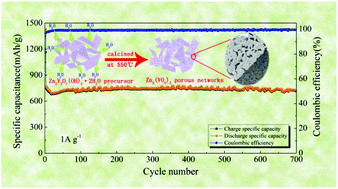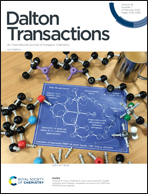Synthesis of nanoparticle-assembled Zn3(VO4)2 porous networks via a facile coprecipitation method for high-rate and long-life lithium-ion storage†
Abstract
A simple coprecipitation route followed by a calcination process was developed to prepare 2D hierarchical Zn3(VO4)2 porous networks formed by the crosslinkage of monolayered nanoparticles. As a promising anode for lithium ion batteries, the electrochemical performance of Zn3(VO4)2 was investigated. At a current density of 1.0 A g−1, the Zn3(VO4)2 porous networks could register a high reversible discharge capacity of 773 mA h g−1 and the capacity retention was 94% after 700 cycles. Moreover, a remarkable reversible discharge capacity of 445 mA h g−1 was achieved at a current density of 5 A g−1 after 1200 cycles. Even at a higher current density of 10.0 A g−1, a high reversible capacity of 527 mA h g−1 could be delivered, which still remained at 163 mA h g−1 after 1200 cycles. This superior performance is attributed to the unique 2D porous networks with a stable structure. This work shows a new avenue for facile, cheap, green, and mass production of zinc vanadate oxides with 2D porous hierarchical networks for next-generation energy conversion and storage devices.



 Please wait while we load your content...
Please wait while we load your content...